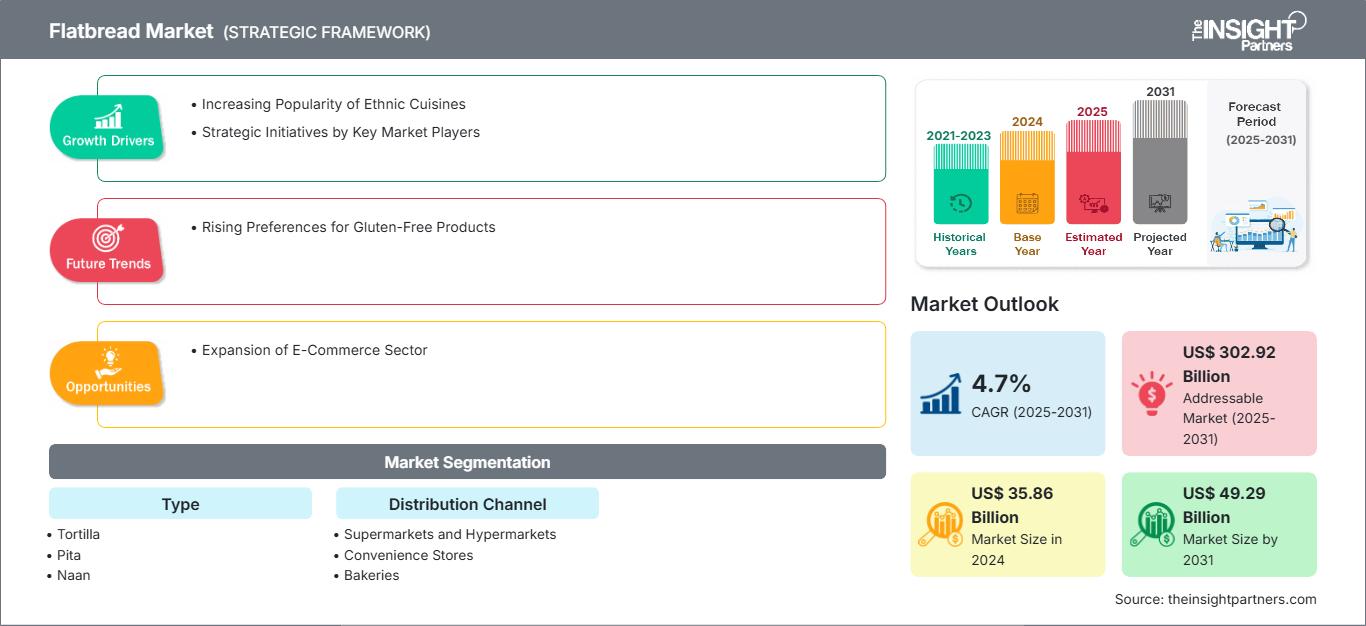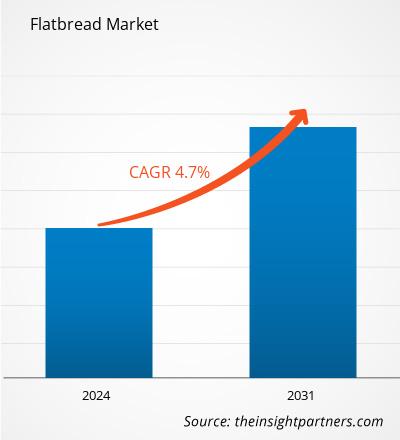Der Fladenbrotmarkt soll von 35,86 Milliarden US-Dollar im Jahr 2024 auf 49,29 Milliarden US-Dollar im Jahr 2031 anwachsen. Für den Zeitraum 2025–2031 wird ein durchschnittliches jährliches Wachstum (CAGR) von 4,7 % erwartet. Die steigende Nachfrage nach glutenfreien Produkten dürfte im Prognosezeitraum neue Trends auf dem Markt mit sich bringen.
Fladenbrotmarktanalyse
Die wichtigsten Wachstumsfaktoren für den Fladenbrotmarkt sind die zunehmende Beliebtheit ethnischer Küchen und die steigende Nachfrage nach glutenfreien Produkten. Strategische Initiativen wichtiger Marktteilnehmer wie Produkteinführungen, Fusionen, Übernahmen, Kooperationen und Partnerschaften tragen ebenfalls zum Marktwachstum bei. E-Commerce-Plattformen bieten Fladenbrotherstellern die Flexibilität, ihre Produkte zu präsentieren und direkt mit den Verbrauchern zu kommunizieren, wodurch die Markensichtbarkeit und die Kundenbindung verbessert werden. Diese Plattformen ermöglichen es Fladenbrotherstellern, durch Datenanalyse wertvolle Einblicke in Verbraucherpräferenzen und Markttrends zu gewinnen und so ihr Produktangebot und ihre Marketingstrategien anzupassen. Der steigende Absatz von Fladenbrotprodukten über E-Commerce und Quick-Commerce-Plattformen dürfte Fladenbrotherstellern im Prognosezeitraum lukrative Möglichkeiten bieten, eine breite Verbraucherbasis zu erreichen.
Marktübersicht für Fladenbrot
Die Nachfrage nach Fladenbroten steigt aufgrund der zunehmenden Vorliebe der Verbraucher für gesündere und abwechslungsreichere Lebensmittel. Da das Gesundheitsbewusstsein weltweit weiter zunimmt, suchen viele Verbraucher nach Alternativen zu herkömmlichem Brot, insbesondere nach solchen, die als leichter gelten oder besondere gesundheitliche Vorteile bieten. Fladenbrote aus Vollkorn, kohlenhydratarmen Optionen und glutenfreien Sorten erfreuen sich bei Verbrauchern, die Wert auf Gewichtskontrolle, eine gesunde Verdauung und ihr allgemeines Wohlbefinden legen, zunehmender Beliebtheit. Dieser Wandel hat Fladenbrothersteller dazu veranlasst, Innovationen zu entwickeln und eine breite Palette gesünderer Fladenbrotprodukte anzubieten, die diesen Anforderungen gerecht werden.
Passen Sie diesen Bericht Ihren Anforderungen an
Sie erhalten kostenlos Anpassungen an jedem Bericht, einschließlich Teilen dieses Berichts oder einer Analyse auf Länderebene, eines Excel-Datenpakets sowie tolle Angebote und Rabatte für Start-ups und Universitäten.
Fladenbrotmarkt: Strategische Einblicke

- Holen Sie sich die wichtigsten Markttrends aus diesem Bericht.Dieses KOSTENLOSE Beispiel umfasst Datenanalysen, die von Markttrends bis hin zu Schätzungen und Prognosen reichen.
Sie erhalten kostenlos Anpassungen an jedem Bericht, einschließlich Teilen dieses Berichts oder einer Analyse auf Länderebene, eines Excel-Datenpakets sowie tolle Angebote und Rabatte für Start-ups und Universitäten.
Fladenbrotmarkt: Strategische Einblicke

- Holen Sie sich die wichtigsten Markttrends aus diesem Bericht.Dieses KOSTENLOSE Beispiel umfasst Datenanalysen, die von Markttrends bis hin zu Schätzungen und Prognosen reichen.
Markttreiber und -chancen für Fladenbrot
Strategische Initiativen wichtiger Akteure
Die steigende Nachfrage nach Fladenbroten ermutigt Branchenakteure, strategische Maßnahmen zur Stärkung ihrer Marktpräsenz zu ergreifen. Weltweit führen Hersteller Fusionen und Übernahmen durch, kooperieren, bringen neue Produkte auf den Markt und setzen andere strategische Initiativen um, um das Interesse der Verbraucher zu wecken und ihre Marktposition zu festigen. Dieses dynamische Umfeld spiegelt die zunehmende Beliebtheit von Fladenbroten weltweit wider, da Marken nach Innovationen streben und den vielfältigen Verbraucherpräferenzen gerecht werden möchten. So kündigte Rise & Puff im März 2023 die Einführung einer neuen Linie echter Tortillas an, die aufgehen. Ziel der Markteinführung ist es, die stark steigende Verbrauchernachfrage nach gesünderen Tortilla-Produkten zu bedienen. Darüber hinaus führen wichtige Marktakteure Produktneuheiten und -entwicklungen durch, um der wachsenden Verbrauchernachfrage nach gesunden Fladenbrot-Alternativen gerecht zu werden. So hat Warburtons beispielsweise im August 2024 Soft Pittas und Fladenbrote in sein Proteinsortiment aufgenommen, die pro Stück acht Gramm Protein bieten. Diese Produkte sind ballaststoffreich, vegan und werden mit einer Mischung aus Hülsenfruchtmehl und Leinsamen gebacken.
Expansion des E-Commerce-Sektors
Da Online-Shopping immer beliebter und bequemer wird, bieten E-Commerce-Plattformen Fladenbrotherstellern einen direkten Kanal, um Verbraucher weltweit zu erreichen. Durch die Nutzung von E-Commerce-Plattformen können Fladenbrothersteller traditionelle Barrieren wie geografische Einschränkungen und Vertriebsherausforderungen überwinden und ihre Marktpräsenz ausbauen. Da Verbraucher aus Bequemlichkeit immer mehr online einkaufen, wird erwartet, dass die Akzeptanz von Fladenbroten aufgrund der größeren Sichtbarkeit und der größeren Produktverfügbarkeit steigt. Laut Agriculture Canada stiegen die E-Commerce-Umsätze im Lebensmittelbereich in den USA zwischen 2019 und 2023 jährlich um 26,4 %.
E-Commerce-Plattformen bieten Fladenbrotherstellern die Flexibilität, ihre Produkte zu präsentieren und direkt mit Verbrauchern zu kommunizieren, wodurch die Markensichtbarkeit und die Kundenbindung verbessert werden. Diese Plattformen ermöglichen es Fladenbrotherstellern, durch Datenanalyse wertvolle Erkenntnisse über Verbraucherpräferenzen und Markttrends zu gewinnen und so ihr Produktangebot und ihre Marketingstrategien anzupassen. Mit der zunehmenden Verbreitung des E-Commerce verstärken Fladenbrothersteller ihre Online-Präsenz, indem sie ihre Produkte über etablierte E-Commerce-Plattformen wie Walmart, Kroger, Amazon.com, Tesco und Sainsbury verkaufen. Die zunehmende Akzeptanz dieser Plattformen beseitigt die Abhängigkeit vom stationären Einzelhandel. Quick-Commerce-Plattformen zielen darauf ab, Kunden küchen- und verzehrfertige Fladenbrote in Rekordzeit zu liefern, typischerweise innerhalb einer Stunde oder weniger. Durch die Nutzung schneller Liefernetzwerke und lokaler Lager sprechen diese Plattformen Verbraucher an, die sofortige Befriedigung suchen. Mit dem Fokus auf Komfort, hochwertiger Verpackung und schnellem Service bietet Quick Commerce eine einzigartige Lösung und schafft ein nahtloses Einkaufserlebnis. Daher wird erwartet, dass der steigende Absatz von Fladenbrotprodukten über E-Commerce und Quick-Commerce-Plattformen den Fladenbrotherstellern in Zukunft lukrative Möglichkeiten bietet, eine breite Verbraucherbasis zu erreichen.
Segmentierungsanalyse des Fladenbrotmarktberichts
Schlüsselsegmente, die zur Ableitung der Fladenbrotmarktanalyse beigetragen haben, sind Typ und Vertriebskanal.
- Basierend auf dem Typ ist der Markt in Tortilla, Pita, Naan und andere segmentiert. Das Tortilla-Segment hatte 2024 einen größeren Marktanteil.
- In Bezug auf den Vertriebskanal ist der Markt in Supermärkte und Hypermärkte, Convenience Stores, Bäckereien, Online-Einzelhandel und andere segmentiert. Das Segment Supermärkte und Hypermärkte dominierte den Markt im Jahr 2024.
Fladenbrot-Marktanteilsanalyse nach Geografie
Der geografische Umfang des Fladenbrotmarktes ist hauptsächlich in fünf Regionen unterteilt: Nordamerika, Asien-Pazifik, Europa, Naher Osten und Afrika sowie Süd- und Mittelamerika.
Fladenbrot erfreut sich in der Asien-Pazifik-Region zunehmender Beliebtheit. Der Fladenbrotkonsum in der Asien-Pazifik-Region steigt aufgrund der zunehmenden Nachfrage nach praktischen und gesunden Nahrungsmitteln, der hohen Bevölkerungszahl der Region, der schnellen Urbanisierung und der sich ändernden Lebensstile. Ungesäuerte Fladenbrote wie Naan, Roti und Chapati sind Grundnahrungsmittel der asiatischen Küche. Gesäuerte Fladenbrote, darunter Pita und Focaccia, erfreuen sich aufgrund des wachsenden Einflusses der westlichen Küche in der Region zunehmender Beliebtheit. Die wachsende Mittelschicht in Ländern wie China, Indien und Japan, das steigende verfügbare Einkommen und die Bereitschaft, mit neuen Nahrungsmitteln zu experimentieren, treiben die Nachfrage nach Fladenbroten an. Die Akzeptanz von Fladenbrot in der Asien-Pazifik-Region steigt, getrieben von Faktoren wie dem zunehmenden Gesundheitsbewusstsein, Bequemlichkeit und dem Wunsch nach Abwechslung bei den Nahrungsmitteln. Darüber hinaus dürften das Aufkommen neuer Akteure, insbesondere im Handwerks- und Gourmetsegment, sowie der zunehmende Einfluss westlicher Essgewohnheiten und -kultur die Nachfrage nach Fladenbroten ankurbeln und so zum Marktwachstum beitragen.
Der Nahe Osten und Afrika zählen zu den wichtigsten Regionen für den Fladenbrotmarkt. Der Einfluss westlicher Esskultur und der Globalisierung fördert den kulturellen Austausch. Die Essgewohnheiten der Verbraucher in der Region verändern sich deutlich: Immer mehr Menschen entdecken eine große Vielfalt internationaler kulinarischer Optionen. Fladenbrote sind vielseitig und einfach zu verwenden und daher für experimentierfreudige Küchenfreunde attraktiv. Sie werden oft in lokale und Fusion-Gerichte integriert und dienen oft als Ersatz für traditionelles Brot in Wraps, Sandwiches und anderen Gerichten. Soziale Medien spielen eine entscheidende Rolle bei der Popularisierung von Fladenbroten, da Foodblogger, Influencer und Kochshows diese vielseitigen Lebensmittel einem breiteren Publikum präsentieren. Spannende Inhalte und optisch ansprechende Präsentationen tragen dazu bei, das Bewusstsein und die Wertschätzung für Fladenbrote bei verschiedenen Verbrauchern zu stärken. Die wachsende Präsenz von sozialen Medien und digitalen Plattformen hat Fladenbrot zu einer trendigen und begehrten Nahrungsmitteloption gemacht und so das Wachstum des Marktes im Nahen Osten und in Afrika vorangetrieben.
FladenbrotmarktFladenbrotmarkt
Die Analysten von The Insight Partners haben die regionalen Trends und Faktoren, die den Fladenbrotmarkt im Prognosezeitraum beeinflussen, ausführlich erläutert. In diesem Abschnitt werden auch die Marktsegmente und die geografische Lage in Nordamerika, Europa, dem asiatisch-pazifischen Raum, dem Nahen Osten und Afrika sowie Süd- und Mittelamerika erörtert.Umfang des Fladenbrot-Marktberichts
Berichtsattribut
Einzelheiten
Marktgröße in 2024
US$ 35.86 Billion
Marktgröße nach 2031
US$ 49.29 Billion
Globale CAGR (2025 - 2031)
4.7%
Historische Daten
2021-2023
Prognosezeitraum
2025-2031
Abgedeckte Segmente
By Typ - Tortilla
- Pita
- Naan
By Vertriebskanal- Supermärkte und Hypermärkte
- Convenience Stores
- Bäckereien
- Online-Einzelhandel
Abgedeckte Regionen und Länder
Nordamerika- USA
- Kanada
- Mexiko
Europa- Großbritannien
- Deutschland
- Frankreich
- Russland
- Italien
- Restliches Europa
Asien-Pazifik- China
- Indien
- Japan
- Australien
- Restlicher Asien-Pazifik
Süd- und Mittelamerika- Brasilien
- Argentinien
- Restliches Süd- und Mittelamerika
Naher Osten und Afrika- Südafrika
- Saudi-Arabien
- Vereinigte Arabische Emirate
- Restlicher Naher Osten und Afrika
Marktführer und wichtige Unternehmensprofile - Kontos Foods
- GRUMA SAB de CV
- FGF Brands Inc
- Joseph's Bakery Ol© Mexican Foods Inc
- General Mills Inc
- Goya Foods Inc
- Mi Rancho
- Leighton Foods AS
- Toufayan Bakeries
Dichte der Marktteilnehmer im Fladenbrotmarkt: Verständnis ihrer Auswirkungen auf die Geschäftsdynamik
| Berichtsattribut | Einzelheiten |
|---|---|
| Marktgröße in 2024 | US$ 35.86 Billion |
| Marktgröße nach 2031 | US$ 49.29 Billion |
| Globale CAGR (2025 - 2031) | 4.7% |
| Historische Daten | 2021-2023 |
| Prognosezeitraum | 2025-2031 |
| Abgedeckte Segmente |
By Typ
|
| Abgedeckte Regionen und Länder | Nordamerika
|
| Marktführer und wichtige Unternehmensprofile |
|
Der Fladenbrotmarkt wächst rasant, angetrieben von der steigenden Endverbrauchernachfrage aufgrund von Faktoren wie sich entwickelnden Verbraucherpräferenzen, technologischem Fortschritt und einem stärkeren Bewusstsein für die Produktvorteile. Mit steigender Nachfrage erweitern Unternehmen ihr Angebot, entwickeln Innovationen, um den Verbraucherbedürfnissen gerecht zu werden, und nutzen neue Trends, was das Marktwachstum weiter ankurbelt.

- Holen Sie sich die Fladenbrotmarkt Übersicht der wichtigsten Akteure
Neuigkeiten und aktuelle Entwicklungen zum Fladenbrotmarkt
Der Fladenbrotmarkt wird durch die Erhebung qualitativer und quantitativer Daten aus Primär- und Sekundärforschung bewertet, die wichtige Unternehmenspublikationen, Verbandsdaten und Datenbanken umfasst. Eine wichtige aktuelle Entwicklung auf dem Fladenbrotmarkt wird nachfolgend erwähnt:
- Old El Paso hat Old El Paso Fiesta Twists vorgestellt, eine neue Ergänzung seines Portfolios an mexikanischen Mahlzeitenlösungen. Es gibt drei köstliche Geschmacksrichtungen: Queso, Zesty Ranch und Cinnamon Churro, die jeweils für ein angenehmes Knuspergefühl sorgen. (Quelle: Old El Paso, Pressemitteilung, Oktober 2022)
- Goya Foods hat seinen Online-Shop zum Hispanic Heritage Month und zu Feiertagen eröffnet. Kunden können Produkte bestellen und sich direkt nach Hause liefern lassen. (Quelle: Goya Foods, Pressemitteilung, Juni 2022)
Bericht zum Fladenbrot-Markt: Umfang und Ergebnisse
Der Bericht „Fladenbrot-Marktgröße und -prognose (2021–2031)“ bietet eine detaillierte Analyse des Marktes und deckt die folgenden Bereiche ab:
- Marktanteil und Prognose für Fladenbrot auf globaler, regionaler und Länderebene für alle abgedeckten wichtigen Marktsegmente
- Markttrends für Fladenbrot sowie Marktdynamik wie Treiber, Einschränkungen und wichtige Chancen
- Detaillierte Porter’s Five Forces- und SWOT-Analyse
- Fladenbrot-Markt mit wichtigen Markttrends, globalen und regionalen Rahmenbedingungen, wichtigen Akteuren, Vorschriften und aktuellen Marktentwicklungen
- Branchenlandschaft und Wettbewerbsanalyse mit Marktkonzentration, Heatmap-Analyse, prominenten Akteuren und aktuellen Entwicklungen für den Fladenbrot-Markt
- Detaillierte Unternehmensprofile
- Historische Analyse (2 Jahre), Basisjahr, Prognose (7 Jahre) mit CAGR
- PEST- und SWOT-Analyse
- Marktgröße Wert/Volumen – Global, Regional, Land
- Branchen- und Wettbewerbslandschaft
- Excel-Datensatz
Aktuelle Berichte
Erfahrungsberichte
Grund zum Kauf
- Fundierte Entscheidungsfindung
- Marktdynamik verstehen
- Wettbewerbsanalyse
- Kundeneinblicke
- Marktprognosen
- Risikominimierung
- Strategische Planung
- Investitionsbegründung
- Identifizierung neuer Märkte
- Verbesserung von Marketingstrategien
- Steigerung der Betriebseffizienz
- Anpassung an regulatorische Trends




















 Kostenlose Probe anfordern für - Fladenbrotmarkt
Kostenlose Probe anfordern für - Fladenbrotmarkt